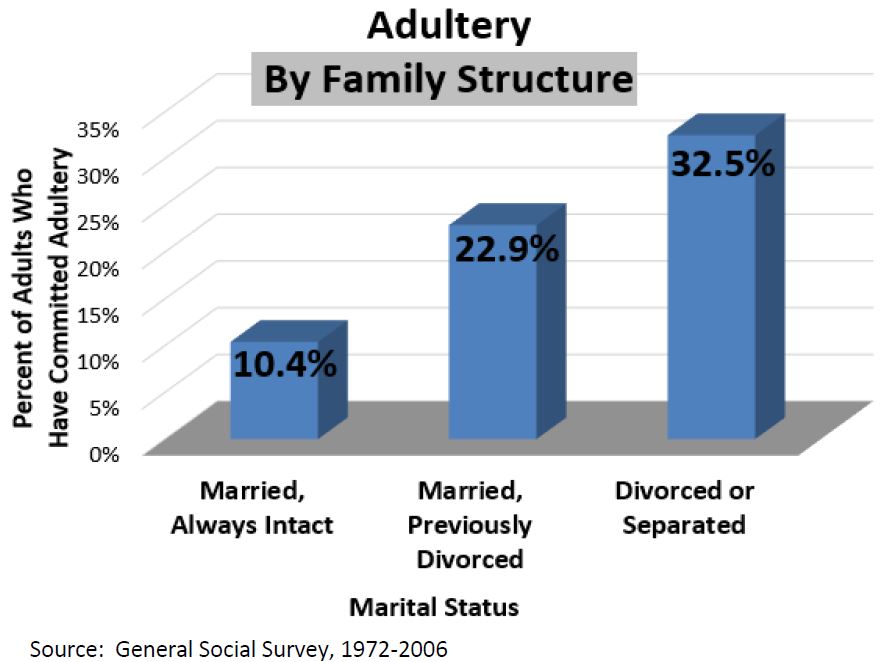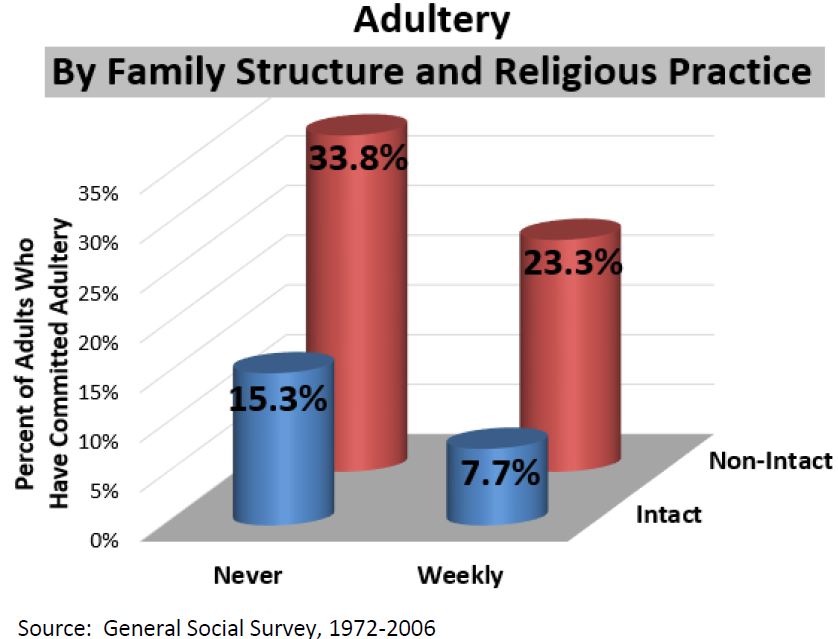Click Here to download “Adultery by Family Structure and Religious Practice”
Adultery by Family Structure and Religious Practice
Family Structure: According to the 1972-1993 General Social Surveys, adults who were married were less likely to have committed adultery than adults who were divorced or separated. Adults in always-intact marriages had the lowest adultery rate (10.4 percent), compared to 22.9 percent of married, previously-divorced adults and 32.5 percent of divorced or separated adults. [1] Religious Practice: Of adults currently or previously married, those who attended religious services once a week or more at the time of the survey were the least likely to have committed adultery. According to the General Social Surveys (GSS), among adults currently or previously married, 12.4 percent who worshiped once a week or more had had sexual relations with someone other than their spouse, followed by 17.1 percent of those who worshiped between one and three times a month, 20.6 percent of those who worshiped less than once a month, and 24.8 percent of those who never attended religious services.
Religious Practice: Of adults currently or previously married, those who attended religious services once a week or more at the time of the survey were the least likely to have committed adultery. According to the General Social Surveys (GSS), among adults currently or previously married, 12.4 percent who worshiped once a week or more had had sexual relations with someone other than their spouse, followed by 17.1 percent of those who worshiped between one and three times a month, 20.6 percent of those who worshiped less than once a month, and 24.8 percent of those who never attended religious services.
 Family Structure and Religious Practice Combined: Adults in always-intact marriages who worshiped at least weekly were the least likely of all to have had adulterous sexual relations. According to the General Social Surveys (GSS), adults in always-intact marriages who attended religious services at least weekly were the most likely to be faithful to their spouses, with an adultery rate of 7.7 percent. Adults in always-intact marriages who never attended worship had a 15.3 percent rate of adultery. Among those who were in non-intact relationships, those who worshiped weekly had a 23.3 percent rate of adultery and those who never worshiped had a 33.8 percent rate of adultery.
Family Structure and Religious Practice Combined: Adults in always-intact marriages who worshiped at least weekly were the least likely of all to have had adulterous sexual relations. According to the General Social Surveys (GSS), adults in always-intact marriages who attended religious services at least weekly were the most likely to be faithful to their spouses, with an adultery rate of 7.7 percent. Adults in always-intact marriages who never attended worship had a 15.3 percent rate of adultery. Among those who were in non-intact relationships, those who worshiped weekly had a 23.3 percent rate of adultery and those who never worshiped had a 33.8 percent rate of adultery.
 Related Insights from Other Studies: Several other studies corroborate the direction of these findings. Amy Burdette of the University of North Carolina and colleagues reported that “frequency of religious attendance is inversely associated with the likelihood of having engaged in infidelity.”[2]
Vaughn Call and Tim Heaton of Brigham Young University found that “of the dimensions of religious experience, attendance has the greatest impact on marital stability.”[3]
Judith Treas of the University of California and Irvine and Deirdre Giesen of Utrecht University also reported that “those who often attended religious services were less likely to have had multiple sex partners in the previous year.”[4]
As the data indicate, the more frequently married adults attend religious services, the less likely they are to be unfaithful to their spouses.
Paul Amato and Denise Previti of Pennsylvania State University reported that infidelity was “the most commonly reported cause of divorce.”[5] This finding follows up a previous study by Paul Amato and Stacy Rogers of the University of Nebraska-Lincoln that infidelity was one of the “most consistent predictors of divorce,” along with jealousy, drug use, drinking, and spending money foolishly.[6]
Studies indicate that dults in always-intact marriages are less likely to have committed adultery than adults who have divorced.
Social science data shows that always-intact married adults who attend religious services at least weekly are the least likely to have committed adultery. Mark Whisman of the University of Colorado at Boulder and colleagues reported that infidelity was “negatively associated with” religiosity and “was predicted by greater marital dissatisfaction.”[7]
Paul Amato and Stacy Rogers of the Pennsylvania State University also found that “frequent church attendance appears to lower the likelihood of divorce” and that infidelity was one of the “most consistent predictors of divorce,” along with jealousy, drug use, drinking, and spending money foolishly.[8]
[1] These charts draw on data collected by the General Social Surveys, 1972-2006. From 1972 to 1993, the sample size averaged 1,500 each year. No GSS was conducted in 1979, 1981, or 1992. Since 1994, the GSS has been conducted only in even-numbered years and uses two samples per GSS that total approximately 3,000. In 2006, a third sample was added for a total sample size of 4,510.
[2] Amy M. Burdette, Christopher G. Ellison, Darren E. Sherkat, and Kurt A. Gore, “Are There Religious Variations in Marital Infidelity?” Journal of Family Issues 28 (2007): 1553-81.
[3] Vaughn R. A. Call and Tim B. Heaton, “Religious Influence on Marital Stability,” Journal for the Scientific Study of Religion 36 (1997): 382-92.
[4] Judith Treas and Deirdre Giesen, “Sexual Infidelity among Married and Cohabiting Americans,” Journal of Marriage and Family 62 (2000): 48-60.
[5] Paul R. Amato and Denise Previti, “People’s Reasons for Divorcing: Gender, Social Class, the Life Course, and Adjustment,” Journal of Family Issues 24 (2003): 602-26.
[6] Paul R. Amato and Stacy J. Rogers, “A Longitudinal Study of Marital Problems and Subsequent Divorce,” Journal of Marriage and the Family 59 (1997): 612-24.
[7] Mark A. Whisman, Kristina Koop Gordon, and Yael Chatav, “Predicting Sexual Infidelity in a Population-Based Sample of Married Individuals,” Journal of Family Psychology 21 (2007): 320-24.
[8] Paul R. Amato and Stacy J. Rogers, “A Longitudinal Study of Marital Problems and Subsequent Divorce,” Journal of Marriage and the Family 59 (1997): 612-24.]]>
Related Insights from Other Studies: Several other studies corroborate the direction of these findings. Amy Burdette of the University of North Carolina and colleagues reported that “frequency of religious attendance is inversely associated with the likelihood of having engaged in infidelity.”[2]
Vaughn Call and Tim Heaton of Brigham Young University found that “of the dimensions of religious experience, attendance has the greatest impact on marital stability.”[3]
Judith Treas of the University of California and Irvine and Deirdre Giesen of Utrecht University also reported that “those who often attended religious services were less likely to have had multiple sex partners in the previous year.”[4]
As the data indicate, the more frequently married adults attend religious services, the less likely they are to be unfaithful to their spouses.
Paul Amato and Denise Previti of Pennsylvania State University reported that infidelity was “the most commonly reported cause of divorce.”[5] This finding follows up a previous study by Paul Amato and Stacy Rogers of the University of Nebraska-Lincoln that infidelity was one of the “most consistent predictors of divorce,” along with jealousy, drug use, drinking, and spending money foolishly.[6]
Studies indicate that dults in always-intact marriages are less likely to have committed adultery than adults who have divorced.
Social science data shows that always-intact married adults who attend religious services at least weekly are the least likely to have committed adultery. Mark Whisman of the University of Colorado at Boulder and colleagues reported that infidelity was “negatively associated with” religiosity and “was predicted by greater marital dissatisfaction.”[7]
Paul Amato and Stacy Rogers of the Pennsylvania State University also found that “frequent church attendance appears to lower the likelihood of divorce” and that infidelity was one of the “most consistent predictors of divorce,” along with jealousy, drug use, drinking, and spending money foolishly.[8]
[1] These charts draw on data collected by the General Social Surveys, 1972-2006. From 1972 to 1993, the sample size averaged 1,500 each year. No GSS was conducted in 1979, 1981, or 1992. Since 1994, the GSS has been conducted only in even-numbered years and uses two samples per GSS that total approximately 3,000. In 2006, a third sample was added for a total sample size of 4,510.
[2] Amy M. Burdette, Christopher G. Ellison, Darren E. Sherkat, and Kurt A. Gore, “Are There Religious Variations in Marital Infidelity?” Journal of Family Issues 28 (2007): 1553-81.
[3] Vaughn R. A. Call and Tim B. Heaton, “Religious Influence on Marital Stability,” Journal for the Scientific Study of Religion 36 (1997): 382-92.
[4] Judith Treas and Deirdre Giesen, “Sexual Infidelity among Married and Cohabiting Americans,” Journal of Marriage and Family 62 (2000): 48-60.
[5] Paul R. Amato and Denise Previti, “People’s Reasons for Divorcing: Gender, Social Class, the Life Course, and Adjustment,” Journal of Family Issues 24 (2003): 602-26.
[6] Paul R. Amato and Stacy J. Rogers, “A Longitudinal Study of Marital Problems and Subsequent Divorce,” Journal of Marriage and the Family 59 (1997): 612-24.
[7] Mark A. Whisman, Kristina Koop Gordon, and Yael Chatav, “Predicting Sexual Infidelity in a Population-Based Sample of Married Individuals,” Journal of Family Psychology 21 (2007): 320-24.
[8] Paul R. Amato and Stacy J. Rogers, “A Longitudinal Study of Marital Problems and Subsequent Divorce,” Journal of Marriage and the Family 59 (1997): 612-24.]]>
